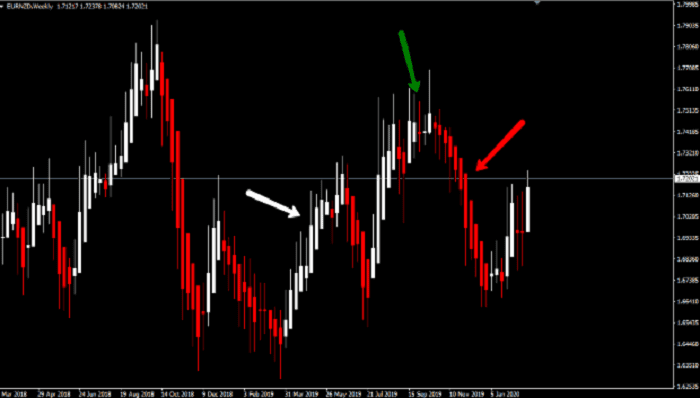Using Heikin Ashi
As with a conventional candlestick chart, you can use the Heikin Ashi on any timeframe.
While they can come in any color, the standard version with the
MetaTrader 4 platform uses red for a bear candlestick, while it will use white for a bull candlestick.
In order to use Heikin Ashi candles on the MetaTrader 4 platform, you go to the pulldown 'insert' menu, click on the 'indicators'' submenu, followed by the 'custom' submenu, and choose 'Heikin Ashi'.
One advantage of the Heikin Ashi indicator is that in a downtrend, candles tend to stay red, while in an uptrend they tend to stay white. Normal candlesticks will sometimes alternate color, even if it is against the overall trend.
You may have a couple of random hourly candlesticks that are slightly bullish in an overall bearish trend. This can make the look of the trend a little noisier than what is either useful or necessary.
There are five main signals that identify trends using Heikin Ashi:
- White candles with no lower “wicks” indicate a strong uptrend.
- White candles in general signify an uptrend.
- Candles with a small body surrounded by both an upper and lower wick suggest that a potential trend change may be presenting itself. (Also known as a “doji”.)
- Red candles indicate a downtrend.
- Red candles with no higher shadows indicate a strong downtrend.

Notice on the chart above that where the white arrow highlights, there are multiple white candlesticks in a row that had no wick on the bottom. This shows that there was in fact a significant uptrend in effect.
Also, notice how there were a couple of candlesticks that had long wicks on both sides highlighted by the green arrow, showing a potential trend change.
Finally, notice that the red arrow points out several red candlesticks in a row that have no upper shadow, showing a very strong downtrend, and change in attitude.
Note that when there are several long wicks in a row on one side of the candle, it can present that there is a significant amount of pressure building in the marketplace. For example, when you see several red candles with long wicks on the bottom, that shows that buying pressure is starting to build.
Ultimately, if you see several white candlesticks in a row that have long wicks to the upside, it also can suggest that selling pressure is starting to make its presence known. The wick suggests that the market was moving in a direction, but in the case of the downtrend found buyers that managed to push back up, and of course vice versa for an uptrend.
Most traders will use Heikin Ashi candlesticks to keep themselves in a trade much longer once a trade begins, choosing not to change their position or close out until the candlestick changes color. For example, if there are four red candlesticks and suddenly a white candlestick appears, then a trader who is short of the market may close out their position, or even possibly go long at that point.
Remember, the candles are meant to change slowly, so the fact that they do suggests something important could be afoot.
However, for those that are more aggressive, the fact that a candle has wicks on both sides of it, or form a doji, will kick off a potential trade in the other direction. It is a matter of personal preference, but it should be tested in a demo environment if you wish to try it out. This is true not only with Heikin Ashi, but any indicator or strategy.